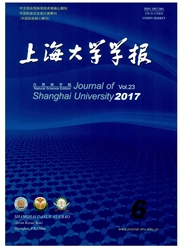

 中文摘要:
中文摘要:
提高了Cu含量的核反应堆压力容器(reactorpressurevessel,RPV)模拟钢样品,经过880℃水淬、660℃调质处理和400oC1000~4000h的等温时效处理,观察到纳米富Cu相的析出;随后进行20%~30%冷轧变形,采用萃取复型(extractionreplica,ER)和高分辨透射电镜(highresolutiontransmissionelectronmicroscopy,HRTEM)的方法研究纳米富Cu相的变形特征.研究结果表明,镶嵌在α—Fe基体中的纳米富Cu相,在冷轧变形时的变形机制较为复杂,存在多种变形方式.当纳米富Cu相的晶体处于有利取向时,可以跟随基体一起发生滑移变形,表现为“软”颗粒的特性;当晶体处于不利取向时,会发生孪生变形,甚至诱发马氏体相变,有时生成“轮毂辐条”状的孪晶结构,大大提高了纳米富Cu相继续变形时的抗力,表现为“硬”颗粒的特征,因而析出纳米富Cu相会产生明显的强化作用.
 英文摘要:
英文摘要:
The nano-scale Cu-rich precipitates in reactor pressure vessel (RPV) model steel after water quenching, tempering and thermal aging at 400℃has been investigated by extraction replica (ER) and high resolution transmission electron microscopy (HRTEM). Samples were cold-rolled by 20% -30% after aging to study the deformation characterization of Cu-rich precipitates. The results show that the deformation characterization of the nanometer Cu-rich precipitates is complicated due to the restriction of α-Fe matrix. Different deformation mechanisms are detected. When the Cu-rieh precipitates are located in a favorable orientation, they will be deformed by slipping together with the deformation of α-Fe matrix to show the particles of "soft" characteristic. When the Cu-rich precipitates are located in an unfavorable orientation, they will be deformed by twinning to form the spoke-like twins within a Cu-rich precipitate, even a martensitic phase transformation induced by strain. In this case, the Cu-rich precipitates show the particles of "hard" characteristic. Therefore the precipitation hardening occurs after the formation of Cu- rich precipitates in α-Fe matrix.
 同期刊论文项目
同期刊论文项目
 同项目期刊论文
同项目期刊论文
 The effect of nanostructural hierarchy on the mechanical properties of aluminium alloys during defor
The effect of nanostructural hierarchy on the mechanical properties of aluminium alloys during defor First principles study of Al and Ni segregation to the alpha-Fe/Cu (100) coherent interface and thei
First principles study of Al and Ni segregation to the alpha-Fe/Cu (100) coherent interface and thei Theoretical prediction of mechanical stability of ferromagnetic FCC Fe-Cu alloys from first principl
Theoretical prediction of mechanical stability of ferromagnetic FCC Fe-Cu alloys from first principl Molecular Dynamics Study of the Response of Nanostructured Al/Ni Clad Particles System under Thermal
Molecular Dynamics Study of the Response of Nanostructured Al/Ni Clad Particles System under Thermal Strengthening effect of Cu-rich phase precipitation in 18Cr9Ni3CuNbN austenitic heat-resisting steel
Strengthening effect of Cu-rich phase precipitation in 18Cr9Ni3CuNbN austenitic heat-resisting steel Combination of TEM and 3D atom probe study on the microstructure and alloy carbide in a Nb-V micro-a
Combination of TEM and 3D atom probe study on the microstructure and alloy carbide in a Nb-V micro-a Comparative Study on Austenite Decomposition and Copper Precipitation during Continuously Cooling Tr
Comparative Study on Austenite Decomposition and Copper Precipitation during Continuously Cooling Tr The precipitation strengthening behavior of Cu-rich phase in Nb contained advanced Fe-Cr-Ni type aus
The precipitation strengthening behavior of Cu-rich phase in Nb contained advanced Fe-Cr-Ni type aus Structure and elastic property of nanosized complex oxide particles in ferritic/martensitic alloy: A
Structure and elastic property of nanosized complex oxide particles in ferritic/martensitic alloy: A The water effect on the structural, electronic and photocatalytic properties of graphitic carbon nit
The water effect on the structural, electronic and photocatalytic properties of graphitic carbon nit Density functional theory study of the influence of Ti and V partitioning to cementite in ferritic s
Density functional theory study of the influence of Ti and V partitioning to cementite in ferritic s 3D atom probe characterization of temporal evolution of precipitates in aging Nb-V micro-alloyed ste
3D atom probe characterization of temporal evolution of precipitates in aging Nb-V micro-alloyed ste Compositional and structural characterization of alloyed carbide by 3D atom probe and high-resolutio
Compositional and structural characterization of alloyed carbide by 3D atom probe and high-resolutio Effects of deuterium implantation and subsequent electron irradiation on the microstructure of Fe-10
Effects of deuterium implantation and subsequent electron irradiation on the microstructure of Fe-10 期刊信息
期刊信息
